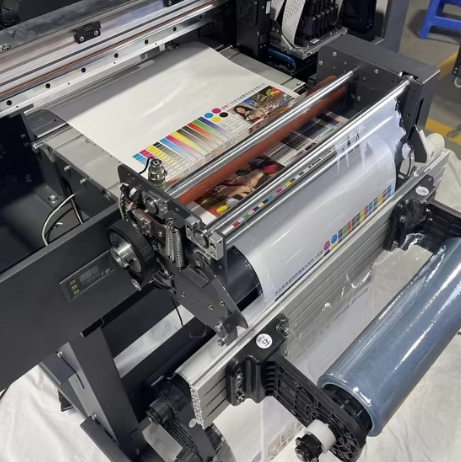Core Technology Comparison: UV DTF vs Traditional DTF Printing
Ink Composition Differences
When looking at the ink differences between UV DTF and regular DTF printing, the main thing that sets them apart is the special UV reactive pigments used in UV DTF inks. What makes these inks so good is they dry almost immediately when hit with UV light, giving prints that last longer and look much brighter. Regular DTF printing usually relies on standard pigment inks that need heat to stick to fabric, while UV DTF gives colors that pop and stay vibrant for years. Eco friendly options are becoming increasingly important across both printing methods too. Many manufacturers now offer certified green inks that actually work well despite being better for the environment. Some printers report no drop in quality even after switching to these more sustainable alternatives.
Top names in the printing business have started to catch on to what makes UV DTF inks stand out. These inks keep their vibrant colors and stay intact even when exposed to different environmental factors. The stuff lasts forever too, which explains why so many shops rely on it for jobs that need to hold up over time. We're seeing this trend play out across the industry as printers switch to UV DTF tech for everything from detailed work requiring sharp lines to projects where rich, eye-catching colors are essential. Many sign makers and textile printers have already made the jump because they simply can't afford to go back once they see the results.
Curing Mechanism Variations
What makes UV DTF printing so special? Well, it all comes down to how it cures prints using ultraviolet light instead of traditional methods. When exposed to UV rays, the ink dries almost instantly, cutting down on wait times and saving energy since there's no need for extra heating steps. This matters a lot when working with delicate fabrics that might get damaged by regular heat treatments. Textile printers have reported being able to handle more jobs per day without compromising print quality, which explains why many shops are switching over to this technology despite the initial investment costs.
Traditional DTF printing relies on heat curing processes that take much longer and need constant temperature control throughout to get decent transfer quality. What happens in practice? Well, this approach tends to produce all sorts of inconsistencies and leaves manufacturers dealing with higher defect rates than they'd prefer. Looking at actual industry data shows something pretty clear: UV DTF printing cures significantly faster than these old methods, and comes with far fewer defects as well. Take a real world scenario where UV curing cuts production time nearly in half when compared against standard heat techniques. That kind of speed makes UV curing especially appealing for operations running at scale. Plus, companies find they can keep output quality stable across batches without burning through as much energy, which speaks volumes about how efficient and dependable these newer UV DTF systems really are.
Production Process Variations
Pre-treatment Requirements
UV DTF printing needs some pretty precise prep work before anything else happens. Most of the time, we're talking about getting surfaces ready so those UV inks stick properly on hard materials such as glass or metal surfaces. Without proper prep, the prints just won't last long or look good over time. Traditional DTF works mainly on fabrics, while UV DTF demands surfaces where UV light actually does something useful during curing for better adhesion results. The way these pre-treatment steps differ matters a lot for how everything gets set up initially and makes all the difference in whether the finished product looks professional or falls apart after a few days.
Traditional DTF printing has its own unique approach when it comes to pre-treatment. When working with fabrics or any kind of soft material, most printers spend time pressing these surfaces first. The goal here is simple really just making sure everything's flat and dry so nothing interferes with the transfer later on. Without this step, the special adhesive powder that makes DTF work properly won't stick right. These extra prep steps definitely complicate things for shop owners both in terms of labor costs and production schedules. Some fabric types with weird textures throw another wrench into the mix too. We've seen cases where prints simply don't last as long because the surface wasn't properly prepared beforehand.
Print professionals consistently emphasize how important proper pre-treatment is for print durability. When surfaces get properly cleaned and treated before printing, the ink sticks better and lasts much longer against everyday wear and tear. This step matters just as much for UV direct-to-film printing as it does for regular DTF processes. Research conducted at several printing labs shows that prints on well-prepared surfaces tend to survive 30-50% longer than those on untreated materials. The difference isn't just about looks either the reduction in defects means fewer returns and happier customers overall. Most shops that skip this step end up spending more money fixing problems down the line.
Post-processing Complexity
When comparing post processing between UV DTF and regular DTF printing, there are some pretty big differences that affect how much time and money gets spent on the job. With UV DTF, finishing up after printing isn't so bad because most of what needs doing is just peeling off the transfer paper and sticking it onto whatever surface they want. No waiting around for ink to dry either thanks to those special UV cured inks. Just pop under a lamp and done! This makes things go much faster overall. For shops running tight deadlines or handling large orders, these savings in both time and labor really add up. A lot of print shops have told me how switching to UV DTF helped them handle rush jobs without breaking a sweat.
Traditional DTF printing comes with quite a few extra steps after the initial application. Once the adhesive powder goes on, someone has to run the design through either a heat press or an oven to set it properly. This takes extra time and demands pretty good attention to detail because things can go wrong easily during this phase. The whole process adds up in terms of labor expenses and slows down production lines, particularly when workers aren't paying close enough attention at every point along the way. When mistakes happen during these later stages, they often result in more rejected prints. Higher rejection rates mean lower profits for businesses and unhappy customers who get subpar products instead of what they ordered.
Looking at the numbers reveals some real efficiency gains worth noting. Take UV DTF for example it tends to cut down on those long wait times after processing and just plain makes fewer mistakes compared to other methods. That's why many companies going for fast turnaround and good quality tend to go this route. Traditional DTF works well across different fabrics but honestly takes longer to finish up, which can really eat into production schedules when deadlines matter. When weighing options between these printing approaches, most shops find themselves thinking about how each one fits what they actually need to get done day to day.
Output Characteristics and Material Compatibility
Texture and Finish Options
Looking at different textures and surface finishes, UV DTF printing stands out from regular DTF methods with quite a few options available. With UV technology, printers can get everything from shiny gloss to flat matte surfaces, plus some really cool 3D effects too. This happens because the printer uses UV light to harden the ink, letting multiple layers stack up and form those special textures. Regular DTF just doesn't have this kind of versatility. Most traditional prints end up with that basic smooth look that feels pretty standard. What makes UV DTF so good is how the ink works. These special inks dry instantly once applied, giving prints that sharp, colorful appearance right away. Traditional DTF inks soak into whatever they're printed on though, creating a softer touch but not as bright colors. Many people who've tried both say they love the bold, lasting quality of UV DTF prints, especially when working on detailed artwork or wanting something that really pops visually.
Material Compatibility Range
The material compatibility of UV DTF printing stands out compared to regular DTF methods. Glass, metal, ceramics alongside standard fabrics all work well with UV DTF technology. Why? Because the special UV curing process lets the ink stick properly even on those tricky non-porous surfaces. Regular DTF works best on fabrics like cotton and polyester but struggles with anything that doesn't absorb ink naturally. There are limits though - really rough textures can mess up the final print quality. Most businesses report better results with UV DTF when working on things other than fabric. The prints last longer and look sharper, which explains why so many companies choose this method for custom promotional items and specialty projects where durability matters most.
Operational and Environmental Considerations
Equipment Maintenance Needs
Printing equipment comes in different types like UV DTF versus regular DTF, and each one needs its own kind of maintenance which really affects how much money gets spent running them day to day. The UV DTF models tend to need less fixing around because they're built better so parts don't wear out as fast. Traditional DTF stuff on the other hand might need checking more often, especially when it comes to all those ink parts getting dirty or blocked up. Because of this, UV DTF machines usually last longer since there's not so much replacing going on. People who work with these printers notice that older style DTF machines get clogged quite a bit during normal operation while UV versions seem to handle this problem better thanks to some cleaning functions built right into the hardware itself. Both kinds still need regular attention though, but one definitely takes less time and effort than the other, making a real difference in what companies end up paying over time when deciding which option works best for their shop.
Environmental Compliance Factors
When it comes to green credentials, UV DTF printing stands out from regular DTF methods. The thing about UV DTF printers is they release fewer Volatile Organic Compounds because those UV inks cure instantly when exposed to light, making the whole process much cleaner for the environment. Traditional DTF printing tells a different story though. These older systems tend to spew out more VOCs, so companies have no choice but to follow all sorts of environmental rules and spend extra on proper waste disposal. Switching to UV DTF tech brings real benefits beyond just being greener. Many manufacturers find they can get those coveted eco-certifications that customers love seeing nowadays. Environmental research shows what we already suspected - UV DTF leaves a smaller footprint than traditional approaches. For companies where going green matters, this makes switching over pretty attractive. Plus, staying compliant with environmental standards doesn't just help the planet; it builds trust with clients who care about sustainability markers on product packaging.
FAQ
What is the main difference between UV DTF and traditional DTF printing?
The main difference lies in their ink compositions and curing processes. UV DTF uses UV-reactive inks that cure under ultraviolet light, offering enhanced durability and vibrancy. Traditional DTF uses standard inks that require heat curing.
Why are pre-treatment requirements important in UV DTF?
Pre-treatment ensures proper ink adhesion, especially on rigid substrates, which is essential for print longevity and quality.
What substrates can UV DTF printing handle?
UV DTF can print on a wide variety of surfaces, including glass, metal, ceramics, and textiles, unlike traditional DTF, which is typically limited to textile materials.
How does UV DTF contribute to environmental sustainability?
UV DTF technology emits lower VOCs due to its immediate ink curing process, making it more eco-friendly compared to traditional DTF methods.

